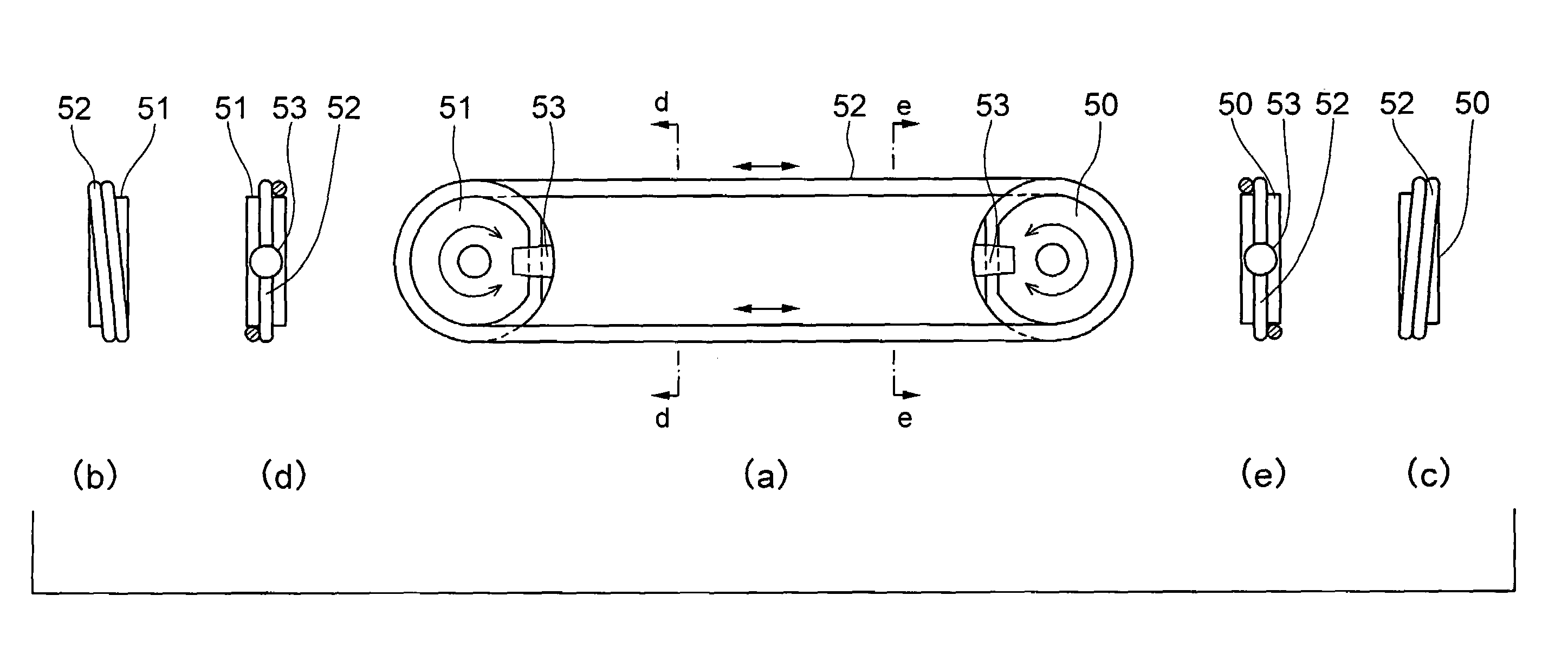Power transmission mechanism and manipulator
a transmission mechanism and manipulator technology, applied in the direction of gearing, surgical forceps, hoisting equipment, etc., can solve the problems of increasing the size and cost of the device, reducing the torque, complicating the mechanism, etc., and achieves sufficient rotational rigidity, enhanced fastening force, and improved fidelity to intended works and controllability
- Summary
- Abstract
- Description
- Claims
- Application Information
AI Technical Summary
Benefits of technology
Problems solved by technology
Method used
Image
Examples
first embodiment
[0057]The wire 52 is loop-shaped, and it is wound on pulleys 5051 by 1.5 turns respectively in this The wire 52 is firmly held on the pulleys 50, 51 by anchor pins 53 (fastening portions). In this configuration, the maximum motion range of ±270 degrees is obtained.
[0058]FIG. 2 shows an example of the entire power transmission system in which a motor 54 with a reducer is associated with the drive pulley 50 whereas an arm 55 is associated with the driven pulley 51. However, the system is not limited to this configuration. Basically, the system is a power transmission mechanism for transmitting power from the drive side to the driven side. Similarly, although FIG. 3 shows an example of incorporating the system in a manipulator 1, combination of the system and the manipulator 1 is not limited to this configuration. The manipulator 1 is composed of a work unit 10, control unit 20, connector unit 30, control unit (not shown), and others, and the operator adjusts the position and attitude...
second embodiment
[0063]FIGS. 8 through 12 are simplified sectional views of the wire / pulley portions at the drive side and the lower side in a power transmission mechanism of a manipulator according to the invention. Here are shown examples of the use of a hollow tube (as a hollow elongate member, also in the description herein below) covering one or both of the spans of the wire 52 between the pulleys 50 and 51, or the use of a solid cord (or a solid rod, as a solid elongate member, also in the description herein below) connecting one or both of the spans of the wire 52 between the pulleys 50 and 51. As shown n these figures, there are various possible ways of connecting the wire 52 to the pulleys, and any of them is employable without problems. In the examples shown in FIG. 9 and FIG. 11, the wire 52 need not pass through the lower hollow tube 60a, but it may be secured to the hollow tube 60a at two or more different points. Since the pull strength of the portions of fixture is usually lower than ...
third embodiment
[0068]FIGS. 15 through 20 are perspective views of manipulators according to the invention and diagrams showing their wire / pulley portions. In the master-slave combined manipulator conjoining the master and the slave, the center of gravity of the driving device is remote from the connector unit 30. Therefore, eccentric mass about the connector unit 30 is produced in most cases. Depending upon the position of the eccentric mass, rotational torque out of the operator's intention may be produced about the connector unit 30 by influences of the gravity, and this may invite degradation of the controllability. Especially in the initial status at the start of controls of the manipulator or in the basic attitude of the manipulator, which is the most standard attitude for controls, if rotational torque is produced by eccentric mass about the connector unit, it will impose useless load to the operator and may invite significant degradation of controllability.
[0069]In most cases, it is the dri...
PUM
 Login to View More
Login to View More Abstract
Description
Claims
Application Information
 Login to View More
Login to View More - R&D
- Intellectual Property
- Life Sciences
- Materials
- Tech Scout
- Unparalleled Data Quality
- Higher Quality Content
- 60% Fewer Hallucinations
Browse by: Latest US Patents, China's latest patents, Technical Efficacy Thesaurus, Application Domain, Technology Topic, Popular Technical Reports.
© 2025 PatSnap. All rights reserved.Legal|Privacy policy|Modern Slavery Act Transparency Statement|Sitemap|About US| Contact US: help@patsnap.com



